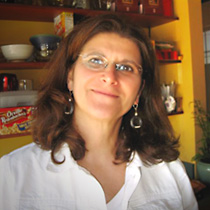Fall 2006
 Influence and Innovation
Influence and Innovation
Welcome to our annual influence issue. It is particularly timely this year, as the new edition of my book, Exercising Influence: Making Things Happen at Work, at Home, and In Your Community has just been published by Pfeiffer. I am also particularly pleased that we were able to influence two outstanding contributors to join Barnes & Conti in recent months. We are delighted they are part of our team and hope many of you will have the pleasure of meeting and working with them soon.
As you may know, I have been very involved in the development of our new Managing Innovation™ program over the past year and it has been one of the most exciting creative and learning experiences I have ever had. As David Francis of CENTRIM and I have deeply explored the research, interviewed practitioners, developed the program architecture, and written the supporting material, I have become convinced that the skills of influence are one of the most important keys to successful innovation management. Here are just a few of the ways in which I believe that influence plays a role:
- During the Searching phase, you need to influence people to focus their creative thinking in a particular direction, to move beyond their boundaries, to look outside the organization, and to see things through the eyes of potential customers.
- During the Exploring phase, you need to influence people to offer their opinions freely and build on one another’s ideas, to offer constructive feedback, to put their ideas to a real test, to involve potential customers and then listen to and accept their feedback.
- During the Committing phase, you need to influence the right people to be involved in the decision process, to make clear decisions about what to do and what to discard, to accept the decisions, to be a sponsor or champion, to offer the resources you need, and to agree to be part of your team.
- During the Realizing phase, you need to influence people to work effectively as a team, to support team decisions, to change the way they do things, to stay out of the team’s way, to give priority to the work of the team, and to meet deadlines.
- During the Optimizing phase, you need to influence people to assess the project and process objectively, to think of new applications and opportunities to use the innovation, to learn from both failure and success, to share what has been learned, and to give credit where credit is due.
Without influence skills, the best ideas will wither on the vine—innovation is not just about having creative ideas, it is about creating value in the real world. Doing so requires engagement with the minds and hearts of other people—and the skillful use of influence.
I wish you a glorious, innovative, and influential fall.
Kim
In this Issue: Our Annual Influence Newsletter
- “Influence in Family Situations,” Janne Rochlin
- What’s New at Barnes & Conti
- Introducing New Staff: Lauren Kline Powers and Grace Boone
- Managing Innovation Successfully Launched
- Barnes & Conti Online: Streaming Audio/Innovation Interviews
- Exercising Influence: The Book Revised
- Wispo: New Global Partner in Germany
- Events, Trade Shows, and Happenings
- Public Programs
- Managing Innovation in the U.K. and Singapore
- 2007 Public Program schedule announced
- Recipes: Janne’s Ratatouille
- Just for Fun
- Featured Art (above): Paul Cezanne, “The Plain at St. Victoire”
Influence in Family Situations
Janne Rochlin, Barnes & Conti Chief Learning Officer
I’ve been training Exercising Influence: Building Relationships and Getting Results™ for nearly ten years. So I should get it, right? Well, I do in my business relationships. To the best of my ability, I practice what I preach. “Say more about that” has become my mantra, keeping me from “over-expressing” which is my default style. So you would think that I do just as well with my family. Think again. What has become second nature to me in my professional relationships has proved to be much more daunting in my family life.
I have a large nuclear family and an even larger extended one, and for the most part, we communicate and influence pretty well. We have spent years building relationships and influencing by “short-hand.” It works in most day-to-day situations, and with some family members it works in more difficult influence situations. Until recently, however, my influence style did not work with my daughter—not at all!
My daughter (I’ll call her Rachel since that’s her name) is a very smart, talented, beautiful, and ultra-dramatic woman. (For those of you who know me, you’ll agree that the apple did not fall far from the tree, it just was bigger, shinier and rolled further.) I guess I figured that since she is my daughter, her communication style and mine would be the same, or at least we would understand one another. That idea worked with her brother and we have no problem with influence. How wrong I was! From the age of about 11, Rachel and I could not talk to one another without one of us nearing explosion. At one point, when she was a teenager, I got her a telephone in her room just so we could talk to one another without being in the same space! What was going on?
I’m a reasonable woman. Just tell me what you need, tell me why you need it and involve me in a discussion by asking an open-ended question like “What do you think?” Don’t butter me up, don’t tell me how you value my contribution, don’t tell me how the world will be a rosier place if you are successful influencing me; just get to the point. The rest of the stuff can come later. Isn’t that how everyone likes to be influenced? Well, apparently not. For ten years, I used that technique on Rachel. (Okay, so maybe I said “here’s what YOU need to do.”) In any event, that style was guaranteed to start a fight and I just couldn’t understand why. Then, in a flash of insight I realized that I was the communication expert! I was the one who was supposed to be able to figure this out! This lack of communication was (gulp!) MY FAULT!
So I began to step back and observe what worked with Rachel. What did she respond to? What was likely to cause a misunderstanding leading to a battle? And here’s what I found out: Rachel responded to “Encourage,” “Envision,” and “Disclose” at the very beginning of a conversation. If I could show her how confident I was about her ability, about what a positive outcome would look like, and about how I needed her input since I did not have all the answers, the conversations would go much more smoothly. I had found a key! It wasn’t the key that opened me up to influence, but it worked with her.
Of course, it is not that simple, but it’s a start. Once I could communicate on a wavelength that she could hear and understand, we were able to deal with issues on a deeper level. Over the past few years, we have been able to get to know one another as adults and to respect one another’s differences and to value those differences. Rachel is open to learning about influence styles and practices what works for me. She takes pride in calling herself my “lab rat” as I try out new behaviors and learnings on her. She now understands and values what I do and passes the knowledge on to others. When she is faced with an influence challenge in her own business, we talk it out. We use the framework and the planning tools to help insure a positive outcome. And she offers my services to her friends when they are facing challenging influence situations!
We still have some of the mother-daughter issues, but now we are able to discuss them and influence one another’s behavior in positive ways. She is still, and always will be, the family “drama queen” (with my granddaughter close behind) and we will always be good friends.
Just the other day, I said to Rachel (only half jokingly) “You’re lucky I’m your mother.” Her reply, “Yeah, I am.”
What’s New at Barnes & Conti?
 Introducing
Lauren Kline Powers,
Introducing
Lauren Kline Powers,
Eastern Regional Director
We are pleased to announce that Lauren Kline Powers has recently joined our organization as the Eastern Regional Director. She is responsible for servicing client relationships and expanding our ever growing client business on the East Coast.
Lauren comes with much experience in the industry. Having worked as a manager, sales professional and consultant, she has over 25 years in training, leadership and organizational development, and human resources. Early in her career, she held a number of internal corporate training positions for large companies. She served as Vice President and Director of Training and Development for CoreStates Financial Corp., and also as a Training Manager at the former Manufacturers Hanover Trust Company and RCA Corporation. She moved in the last fifteen years to externally consult, and spent many years as the Eastern Regional Sales Manager for Situation Management Systems, Inc. developing territories, servicing clients with their training and consulting needs, coordinating sales and support teams and growing revenues.
While the focus of Lauren’s job is in sales and account management, her clients appreciate her expertise in training program design and delivery, needs analysis, customization, organizational consulting, curriculum development, process facilitation and coaching as they collaborate to craft solutions. She has worked with clients across industries including financial services, pharmaceuticals, technology, consumer products and telecommunications.
Residing with her husband, Bob, an architectural preservationist in Philadelphia, Lauren keeps busy with her two children, Olivia, age 13, and Emma, a college sophomore. Norbeart, a pleasantly neurotic golden retriever, and Mel, a spirited black lab, round out their family routine, or lack thereof. Lauren confesses she is an obsessed “foodie” and enjoys cooking and all types of food-related travel adventures; a sure fit with the Barnes & Conti family and its epicurean northern California location.
Lauren can be contacted at 215.232.1611 or lpowers AT barnesconti.com
 Managing
Innovation Successfully Launched
Managing
Innovation Successfully Launched
Our new program, Managing Innovation: Optimizing the Power of New Ideas™ was successfully piloted in New York City this past July, in Munich this past August, and in California this past October. We’re delighted to report rave reviews for the program on both sides of the Atlantic.
Here are a few comments:
- “Right balance of content + practical exercises and real life examples. Excellent material!”
- “I can apply these principles/framework not only within my immediate group, but also within the organization and company as a whole.”
- “The journey model and process was excellent....and got us excited.”
For more information about Managing Innovation, please visit our website,
Barnes & Conti Online: Streaming Audio/Interviews on Innovation
We recently added audio to our website in the form of two interviews with Dr. David L. Francis, Deputy Director of CENTRIM, the University of Brighton’s Centre for Research in Innovation Management in the U.K. In this series of brief interviews, our own Kim Barnes speaks to David Francis on innovation management (part 1) and research of organizational capabilities in innovation management (part 2). We will be adding even more audio features in the very near future.
 Exercising Influence: The Book Revised
Exercising Influence: The Book Revised
The book, Exercising Influence: A Guide For Making Things Happen at Work, at Home, and in Your Community, by Kim Barnes has been revised and is available through Pfeiffer. Pfeiffer is also publishing a self-study guide as well as a leaders’ discussion guide to go with the book. The book description is below:
Influence is a skill-set that everyone needs; yet the necessary techniques and fundamentals of exercising influence are rarely taught. In this revised edition of Exercising Influence, Kim Barnes draws on her thirty years of consulting, teaching and observation to demystify the process of influencing others. This vital resource teaches how to accomplish more with less effort. It shows readers how to create work, family, and community relationships that are more balanced and mutually rewarding, and to take charge of their lives in a powerful, ethical, and productive way.
For more information, or to order the book, visit Pfeiffer’s website.
 Wispo:
New Global Partner in Germany
Wispo:
New Global Partner in Germany
Barnes & Conti has formalized ties with a global partner in Germany, Wispo, Wiesbaden Institute for Systems Psychology and Organizational Development (Das Wiesbadener Institut für systemische Psychologie und Organisationsberatung). Wispo currently offers sales and leadership training programs and provides a range of coaching and organizational services.
Wispo has begun translating several of our programs into German.
Events, Trade Shows, and Happenings
Corporate University Week
November 13-15, 2006
Orlando, FL
Barnes & Conti will be an exhibitor. Please stop by and say hello! We’ll be at booth 115. For information about the conference, please go to the Corporate University website.
Training 2007 Conference and Expo
February 27-28, 2007
Orlando, FL
Barnes & Conti will be an exhibitor at Training Magazine’s annual conference. For information about the conference, please go to the Training Conference website. We will be at booth 601.
SHRM Global Forum
March 19-20, 2007
Los Angeles, CA
Barnes & Conti also be at the Society for Human Resource Management’s Global Forum. Please watch our website, as we’ll be posting information as it becomes available.
Upcoming Public Programs
Exercising Influence
November 6-7, San Francisco, CA
There are some seats left for a public offering of our new highly popular Managing Innovation course in the United Kingdom and in Singapore.
- United Kingdom: On December 12-13 the program will be offered at CENTRIM in Brighton.
- Singapore: On January 18-19 in Singapore we will also be offering the workshop.
For more information, please contact Carter Serrett at lpowers AT barnesconti.com
NEWS FLASH! Much of the 2007 Public Program Schedule is now available online! Be sure to mark your calendar to attend our January 4-5 Managing Innovation program in Washington, DC. Also, please watch the website for additional public program dates.
To
register for one of our public programs, click here
or go to: www.barnesconti.com/ppsched.php
 Featured Recipe: Janne’s
Ratatouille
Featured Recipe: Janne’s
Ratatouille
Ratatouille is a traditional French Provençal stewed vegetable dish which can be served as a meal on its own (accompanied by rice, potatoes, or simply French bread), or as a side dish. Tomatoes are a key ingredient, with onions, zucchini (courgettes), eggplant (aubergine), a little herbs, and sometimes basil.
The name of the dish appears to derive from the French touiller, to stir, although the root of the first element “rat-” slang from the French Army meaning chunky stew. The word ratatouille has also come to be used in non-culinary contexts in English to refer to a (generally colorful) mixture of any kind.
Ingredients:
- 1 medium eggplant
- 3-4 small to medium zucchini
- 3-4 small to medium yellow squash
- 6-8 oz. sliced mushrooms
- 1 medium onion, chopped
- 2 gloves garlic, minced or crushed
- 1 large can diced tomatoes in juice
- Tomato juice or V8
- 1 tbsp. Italian seasoning
- Salt and Pepper to taste
Method:
- Peel and cut the eggplant into 1" cubes. Slice the zucchini and yellow squash.
- Combine all the vegetables and seasoning in a large pot. Summer over a medium low flame. If the mixture seems dry, add tomato juice or V8.
- Stew until all the vegetables are as soft as you like them
Experiment with this dish. Many people like it with bell peppers and other vegetables. Others sauté the vegetables in olive oil before letting them stew together. Sometimes I add olive oil to the stew for additional flavor. Season it any way you please.
The above serves 8-12 generously as a side dish. I usually double or triple the recipe and freeze individual servings for a quick (microwaved) lunch over rice or pasta.
 Just for Fun
Just for Fun
Innovation
Gone Awry?
The Impossible Coffeepot
We’re not saying that this coffeepot is what happens when innovation happens apart from influence—but it could.
This innovative “Coffeepot for Masochists” was designed by French artist Jacques Carelman to be totally unusable, unless of course, you want to pour hot liquid all over yourself!
How NOT to Influence?
 A man in a hot air balloon realized he was lost.
He reduced altitude and spotted a woman below. He descended a bit more and shouted,
“Excuse me, can you help me? I promised a friend I would meet him an hour ago, but I don't know where I am.”
A man in a hot air balloon realized he was lost.
He reduced altitude and spotted a woman below. He descended a bit more and shouted,
“Excuse me, can you help me? I promised a friend I would meet him an hour ago, but I don't know where I am.”
The woman below replied,“You are in a hot air balloon hovering approximately 30 feet above the ground. You are between 40 and 41 degrees north latitude and between 59 and 60 degrees west longitude.”
“You must be an engineer,” said the balloonist.
”I am,” replied the woman, How did you know?”
“Well,” answered the balloonist,“ everything you told me is, technically correct, but I have no idea what to make of your information, and the fact is I am still lost. Frankly, you've not been much help so far.”
The woman below responded,“You must be in management.”
“I am,” replied the balloonist,“but how did you know?”
“Well,” said the woman, “you don't know where you are or where you are going. You have risen to where you are due to a large quantity of hot air. You made a promise which you have no idea how to keep, and you expect people beneath you to solve your problems. The fact is you are in exactly the same position you were in before we met, but now, somehow, it's my fault.”
Please send feedback to newslettr1
at barnesconti.com
Barnes & Conti, 940 Dwight Way Suite 15, Berkeley, CA 94710, USA
Copyright © 2006 Barnes & Conti Associates, Inc. ALL RIGHTS
RESERVED.
